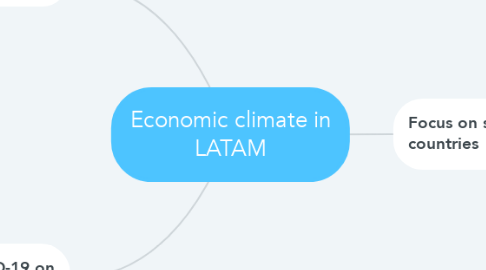
1. The global situation of LATAM
1.1. Growth of the economy
1.1.1. 2019
1.1.1.1. 0,1%
1.1.2. 2020
1.1.2.1. 1,4% expected
1.2. The importance of the region
1.2.1. The region is one the best partner with United States
1.2.2. Mexico is a better trade partner than China with the US
1.2.3. Large part of informal economy
1.2.4. The biggest economic pronlem : the weak rule of law
2. Focus on some Latin american countries
2.1. Chile
2.1.1. Social explosion : street revolts
2.1.1.1. Short-term economic damage : 2 billions of $
2.1.1.2. There will be long term consequences, such as the 2008 recession
2.2. Brazil
2.2.1. Liberalize its economy
2.2.2. The government is retaining the power
2.2.3. The issue : reach a consensus between sustainable and workable situation
2.2.4. Brasil has an important impact on the region
2.3. Mexico
2.3.1. Main partner of the USA for LATAM
2.3.2. Still some drug cartels and crony capitalists which could affect the prosperity of the country
2.4. Argentina
2.4.1. Thirs largest economy of the region
2.4.2. Intervensionist government
2.4.3. Some companies could leave from Argentina
2.5. Colombia
2.5.1. A country that try to overpass the conflict of the narco-guerillas
2.5.2. The priority is the governability of Colombia
2.6. Peru
2.6.1. Good economic trend
2.6.1.1. However, too mcuh people work in the extra-legal sector (70%)
2.6.1.2. Leader in mining
2.6.2. An unstable political situation : suicide, presidents indicted, etc..
2.7. Bolivia
2.7.1. The following presidential elections will be importants
2.8. Venezuela
2.8.1. The end of the Chavez and Maduro dictatorships
2.8.2. An interim president : Juan Guaido
2.8.3. Economic and currency crisis
3. The impact of COVID-19 on LATAM economy
3.1. Maybe the deepest recession in modern history
3.1.1. Collapse in exports
3.1.2. Pullback in tourism
3.1.3. Turbulence in financial markets
3.1.4. Strain to public healthcare systems
3.1.5. Blow to remittances
3.1.6. Dowturn in primary commodity prices
3.1.7. Loss of value for the currency
3.1.8. Inflation
